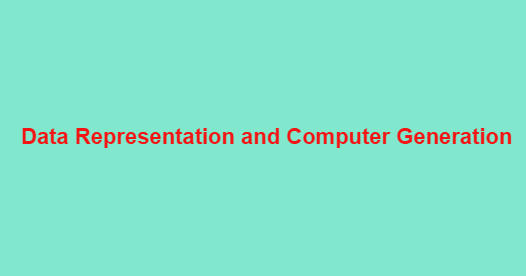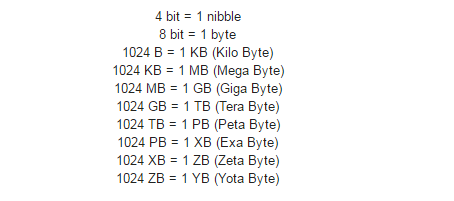
Hello Readers,
Here we are presenting to you all the "Quick Notes on Computer", which can be expected in the ongoing SBI Clerk 2016 Exam.
Data Representation
Memory Units:
Memory unit is
• The amount of data that can be stored in the storage unit.
• That in which storage capacity is expressed in terms of Bytes.
Bit (Binary Digit)
A binary digit is logical 0 and 1 representing a passive or an active state of a component in an electric circuit.
Nibble
A group of 4 bits is called nibble.
Byte
A group of 8 bits is called byte. A byte is the smallest unit which can represent a data item or a character.
Word
A computer word, like a byte, is a group of fixed number of bits processed as a unit which varies from computer to computer but is fixed for each computer.
The length of a computer word is called word-size or word length and it may be as small as 8 bits or may be as long as 96 bits. A computer stores the information in the form of computer words.
Bit < Byte < KB < MB < GB < TB < PB < XB < ZB < YB
bit (b)
Byte (B)
Mbps - mega bits per sec.
MBps - mega Bytes per sec.
• The information you put into the computer is called Data.
•Information of a computer is stored as Digital Data.
•A number system defines a set of values that is used to represent Quantity.
•The modern computers are operated in Binary Number System.
Binary Number System
Name the most significant bit, which represent 1 and 0 for a positive number and negative number, respectively.
Sign Bit
ASCII, EBCDIC and Unicode are the most commonly used codes under this scheme.
Binary Coding Scheme
•EBCDIC is a 8-Bit code with 256 different representations of characters. It is mainly used in mainframe computers.
•EBCDIC stands for Extended Binary Coded Decimal Interchange Code
•In the Hexadecimal Number System each number represents a power of 16. To represent the decimal numbers, this system uses numbers from 0 to 9 and characters from A to F to represent numbers 10-15, respectively. It is commonly used as a shortcut notation for groups of four binary digits.
•BCD is a method that represents the decimal digits with the help of binary digits. It takes advantage that one decimal numeral can be represented by 4-bit pattern. BCD stands for Binary Coded Decimal.
•This coding system is used to represent the interval storage area of the computers. In this system, every character is represented by a combination of bits. Binary Coding System.
•The Base or Radix of the decimal number system is 10.
•The arithmetic operations (addition, subtraction, multiplication and division) performed on the binary numbers is called Binary Arithmetic.
•What is the standard code the computer industry created to represent characters? American Standard Code for Information Interchange (ASCII).
•ASCII is a code used for standardizing the storage and transfer of information amongst various computing devices.
•It is required for representing more than 64 characters. At present, the mostly used coding systems are ASCII and EBCDIC.
•Which code is also known as Reflected Code? - Gray Code
•The 7-bit ASCII code is widely used for Two (0 or 1)
•In the binary language, each letter of the alphabet, each number and each special character is made up of a unique combination of Eight Bits.
Generation of Computer
Which was the first general purpose computer, designed to handle both numeric and textual information? Universal Automatic Computer (UNIVAC) (1951).
First Generation (1940-1956) Vacuum Tubes
•The first computers used vacuum tubes for circuitry and magnetic drums for memory, and were often enormous, taking up entire rooms.
•The UNIVAC and ENIAC computers are examples of first-generation computing devices.
•In first generation of computer, this operating system allowed only one program to run at a time and a number of input jobs are grouped for processing. It is known as Batch Processing.
Second Generation (1956-1963) Transistors
•Transistors replaced vacuum tubes and ushered in the second generation of computers.
Third Generation (1964-1971) Integrated Circuits
•The development of the integrated circuit was the hallmark of the third generation of computers. Transistors were miniaturized and placed on silicon chips, called semiconductors, which drastically increased the speed and efficiency of computers.
Fourth Generation (1971-Present) Microprocessors
•The microprocessor brought the fourth generation of computers, as thousands of integrated circuits were built onto a single silicon chip.
What in the first generation filled an entire room could now fit in the palm of the hand.
•Fourth generation computers also saw the development of GUIs, the mouse and handheld devices.
Fifth Generation (Present and Beyond) Artificial Intelligence
•Fifth generation computing devices, based on artificial intelligence, are still in development, though there are some applications, such as voice recognition, that are being used today.
•In 1981 IBM introduced its first computer for the home user, and in 1984 Apple introduced the Macintosh.


Join The Discussion